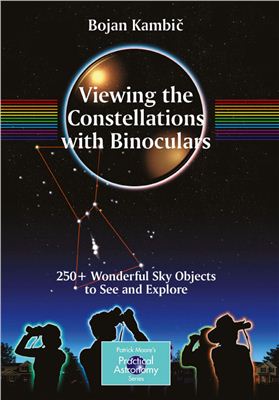Springer, 2009. - 510 Pages. Patrick Moore's Practical Astronomy
Series.
Viewing the Constellations with Binoculars is a complete guide to practical astronomy, written for beginners, intermediate-level astronomers, and even people who have not yet tued their gaze to the night sky. The required observing equipment to get the full value from this book is no more than a pair of regular 10 x 50 binoculars, but even more can be seen with a small astronomical telescope.
This comprehensive introduction to astronomy and practical observing is far more than a guide to what can be seen in the night sky through binoculars. It introduces the reader to some basic (and some not-so-basic) astronomical concepts, and discusses the stars and their evolution, the planets, nebulae, and distant galaxies. There is a guide to selecting and using binoculars for astronomy, as well, as a ‘getting ready to observe’ section containing invaluable practical hints and tips.
The second part of the book is an extraordinarily complete atlas and guide to the night sky down to 30? N (covering all the USA and Europe). It is illustrated with superb and sometimes beautiful amateur astronomical photographs, detailed maps (down to 5th magnitude), descriptions, and data on all astronomical objects of interest.
Viewing the Constellations with Binoculars is a complete guide to practical astronomy, written for beginners, intermediate-level astronomers, and even people who have not yet tued their gaze to the night sky. The required observing equipment to get the full value from this book is no more than a pair of regular 10 x 50 binoculars, but even more can be seen with a small astronomical telescope.
This comprehensive introduction to astronomy and practical observing is far more than a guide to what can be seen in the night sky through binoculars. It introduces the reader to some basic (and some not-so-basic) astronomical concepts, and discusses the stars and their evolution, the planets, nebulae, and distant galaxies. There is a guide to selecting and using binoculars for astronomy, as well, as a ‘getting ready to observe’ section containing invaluable practical hints and tips.
The second part of the book is an extraordinarily complete atlas and guide to the night sky down to 30? N (covering all the USA and Europe). It is illustrated with superb and sometimes beautiful amateur astronomical photographs, detailed maps (down to 5th magnitude), descriptions, and data on all astronomical objects of interest.

